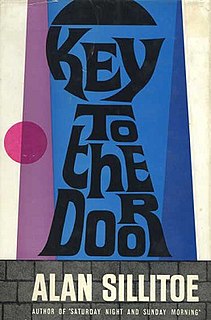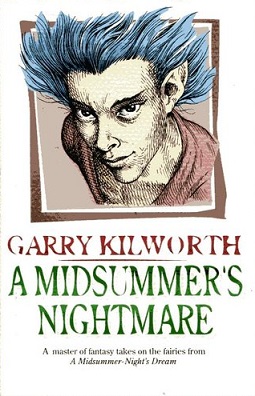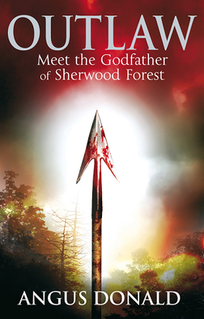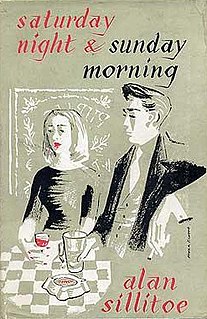 W
WBows Against the Barons is a 1934 children's novel by British author Geoffrey Trease, based on the legend of Robin Hood. It tells the story of an adolescent boy who joins an outlaw band and takes part in a great rebellion against the feudal elite. Trease's first novel, Bows Against the Barons marks the start of his prolific career as a historical novelist. It is notable for reinterpreting the Robin Hood legend and revitalizing the conventions of children's historical fiction in 20th-century Britain.
 W
WDown Ryton Water is a children's historical novel by Eva Roe Gaggin. It tells the story of the Separatists of Scrooby and the Pilgrim Fathers through the first-person narrative of young Matt Over. The novel, illustrated by Elmer Hader, was first published in 1941 and was a Newbery Honor recipient in 1942.
 W
WKey to the Door is a novel by English author Alan Sillitoe, first published in 1961.
 W
WLady Chatterley's Lover is a novel by English author D. H. Lawrence, first published privately in 1928 in Italy and in 1929 in France. An unexpurgated edition was not published openly in the United Kingdom until 1960, when it was the subject of a watershed obscenity trial against the publisher Penguin Books. Penguin won the case and quickly sold three million copies. The book was also banned for obscenity in the United States, Canada, Australia, India, and Japan. The book soon became notorious for its story of the physical relationship between a working-class man and an upper-class woman, its explicit descriptions of sex, and its use of then-unprintable four-letter words.
 W
WLady of Sherwood is a 1999 historical fiction novel by American author Jennifer Roberson. It is a sequel to her 1992 novel Lady of the Forest, and follows Robin Hood, Lady Marian, and their associates, as they fight injustices in the wake of the death of King Richard. They must fight the machinations of Prince John, who is competing for the throne against his young nephew, Arthur of Brittany.
 W
WLady of the Forest: A Novel of Sherwood is a 1992 historical fiction novel by American author Jennifer Roberson. A re-telling of the Robin Hood legend from the perspective of twelve characters associated with the legend, the story centers around English noblewoman Lady Marian FitzWalter's encounters with Lord Robert of Locksley and his scheming rival the Sheriff of Nottingham amid the backdrop of Prince John's schemes – he aims to increase his own wealth and power at the expense of post-Conquest England and his brother, King Richard.
 W
WThe Last Arrow is a 1997 historical novel by Canadian author Marsha Canham, the third instalment of her "Medieval" trilogy inspired by the Robin Hood legend set in 13th-century England. The novel was published by Dell Publishing in 1997 as a sequel to Canham's 1994 story In the Shadow of Midnight. It received generally positive reviews from book critics.
 W
WMaid Marian is a novella by Thomas Love Peacock, his fourth long work of fiction, published in 1822.
 W
WThe Merry Adventures of Robin Hood of Great Renown in Nottinghamshire is an 1883 novel by the American illustrator and writer Howard Pyle. Consisting of a series of episodes in the story of the English outlaw Robin Hood and his band of Merry Men, the novel compiles traditional material into a coherent narrative in a colorful, invented "old English" idiom that preserves some flavor of the ballads, and adapts it for children. The novel is notable for taking the subject of Robin Hood, which had been increasingly popular through the 19th century, in a new direction that influenced later writers, artists, and filmmakers through the next century.
 W
WA Midsummer's Nightmare (1997) is a novel by Garry Kilworth. It is a comical parody of William Shakespeare's A Midsummer Night's Dream.
 W
WOutlaw is the first novel of the eight-part Outlaw Chronicles series by British writer of historical fiction, Angus Donald, released on 10 July 2009 through Little, Brown and Company. The début novel was relatively well received.
 W
WThe Outlaws of Sherwood is a retelling of the legend of Robin Hood by Robin McKinley. In McKinley's afterword, she says, "The retellings through the centuries have echoed concurrent preoccupations." The story includes both the traditional Robin Hood characters — Little John, Much, Friar Tuck, Marian and Alan-a-dale — and characters of McKinley's own invention. Notably, three of the most important characters are women, all of whom escape marriage to prospective spouses chosen by their fathers.
 W
WThe Rainbow is a novel by British author D. H. Lawrence, first published by Methuen & Co. in 1915. It follows three generations of the Brangwen family living in Nottinghamshire, particularly focusing on the individual's struggle to growth and fulfilment within the confining strictures of English social life. Lawrence's 1920 novel Women in Love is a sequel to The Rainbow.
 W
WSaturday Night and Sunday Morning is the first novel by British author Alan Sillitoe and won the Author's Club First Novel Award.
 W
WSons and Lovers is a 1913 novel by the English writer D. H. Lawrence, originally published by Gerald Duckworth and Company Ltd., London, and Mitchell Kennerley Publishers, New York. While the novel initially received a lukewarm critical reception, along with allegations of obscenity, it is today regarded as a masterpiece by many critics and is often regarded as Lawrence's finest achievement.
 W
WTo Fear a Painted Devil is a novel by British writer Ruth Rendell. It was published in 1965, and was the author's second novel.
 W
WThe Unfortunates is an experimental "book in a box" published in 1969 by English author B. S. Johnson and reissued in 2008 by New Directions. The 27 sections are unbound, with a first and last chapter specified: the 25 sections between them, ranging from a single paragraph to 12 pages in length, are designed to be read in any order, giving a total of 15.5 septillion possible combinations that the story can be read in. Christopher Fowler described it as "a fairly straightforward meditation on death and friendship, told through memories." Jonathan Coe described it as "one of the lost masterpieces of the sixties".
 W
WThe White Peacock is the first novel by D. H. Lawrence, published in 1911, though with 1910 on the title page. Lawrence started the novel in 1906 and then rewrote it three times. The early versions had the working title of Laetitia.